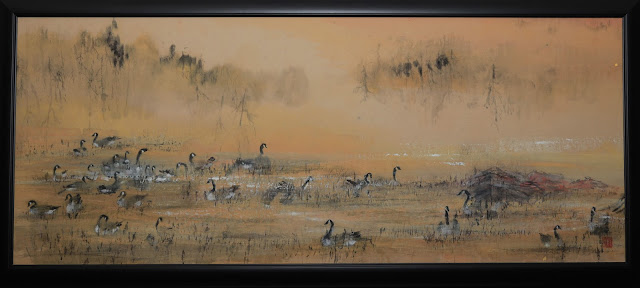Not having a lot of places to visit due to the pandemic, I am relying more on electronic means to keep up with the real world and to let my acquaintances know that I am still kicking and breathing. I must say that it feels good to re-connect with people whom I've grown distant for some reason. One thing is for sure, junk mails are still annoying.
The unforeseen current events not only shut down my demonstration sessions but also threw a monkey wrench into my applications for a chance to exhibit my works. Dates were either canceled or postponed, meaning the adjudication process was put on hold too. One of the venue would adopt a strictly virtual environment, showcasing accepted works online, with no provision for physical viewing. Applicants were told to spruce up their websites so that interested parties would have a chance to scrutinize works other than the juried ones. My in-box finally popped a "Not Chosen" response from a gallery. In the rejection email, there was the usual generic explanation and thank you for your interest verbiage but also there was something more specific to the effect that due to the prevailing events on the streets, a lot of the accepted works somehow showed people's reaction to the issues of our society, as in their facial expressions.
What was not expected was a second communication from the gallery, trying to dispel the impression that somehow the accepted works were all portraits. It went on to say that the call was for works that the artists deem to have left a mark. Thus works that reflect the current state of affairs were more relevant and congruent with the mission.
Obviously what I consider as my mark is markedly different from other people's mark. Since I am not the person marking the mark, who am I to say that so and so missed the mark. Some will argue that galleries and museums often dictate what is relevant art or not, thus molding and shaping the public at large. Is this insidious systemic bias? Who knows, let's not make a mountain out of a mole hill, right?
Actually this reminds me of my Yang Pass Three Variations blog. One might say that I detest the literal meaning of the poem by Wang Wei. It should be evident by now that I belong to the camp that says the poem described the parting sorrow and helplessness between friends. Thus I subscribe to "willow" being a homophone to "stay" in the Chinese language, and dust and misty sprinkle setting the stage for an excursion, a journey that Wang Wei's friend must partake; hence Wang Wei's apprehension. So if I was the gallery setting out a call for Yang Pass theme paintings, I would have rejected all works that would depict willow trees, travel lodges or misty wet roads. I would say that these works are all too banal and superficial and fail to capture the essence of the poem. Am I influencing people's interpretation of the poem or which paintings are relevant? You bet I am. It is my prerogative.
Thus I felt inspired to have another try at painting Yang Pass, based on Wang Wei's poem. Allow me to repeat my translation of that poem:
The city was shrouded in a light sprinkle, settling the dust of the road.
Willows by the inn sprouting green color.
Bottoms UP, let's finish yet another drink,
beyond Yang Pass there shall be no old acquaintances to be found.
As I noted in my past blog, Yang Pass is a military outpost on the southern branch of the Silk Road.
I imagined it to be a stone fortress by a desert that goes on forever. A most inhospitable environment.
I want to elicit the feeling of abandonment and destitute by giving the desert some context. I chose to frame the desert through an window from the outpost. Through this opening I hope to instill a feeling of departure, of distance and of an incessant intrepid crossing.
I laid down the blocks of stone with ink, side-tipped fashion. I chose such archway hoping to reflect an Islamic motif, since the outpost is on the Silk Road and I imagined the architecture could reflect adjacent foreign influences.
The massive stone blocks were easy to paint, and should offer a stark contrast to the proportionally diminutive, yet relentless sandy desert.
The poem alluded to parting of Wang Wei from his friend, who was traveling by himself now.
I don't know what his friend would choose as transportation, but I think a camel is more likely than a horse, since it involved trekking a desert.
I chose a bactrian camel. I had no way of knowing, just thinking that two humps are better than one. Naughty, Naughty! Don't forget the 17th of August is National Hump Day for the States.
I also thought that walking with the camel would be more endearing than riding it. The poem implied that the traveler would be hard pressed to find any old acquaintances, thus walking shoulder to shoulder on equal footing with another being, a camel notwithstanding, could be a more likely sentiment.
Oops, my lawn grass is stilling growing despite the upheavals out there. Time to mow my yard. Good place for an intermission.





















































